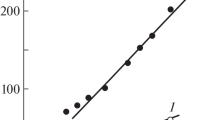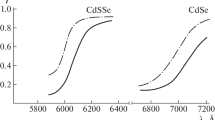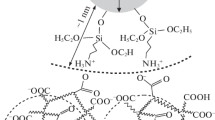The interband absorption spectrum of microscopic CdS crystals ranging in size from ~30 to 800 Å and dispersed in a transparent insulating matrix has been studied. There is a significant (~0.8-eV) shift of the fundamental absorption edge in the short-wavelength direction, and there are oscillations in the interband absorption spectrum caused by quantum size effect.
Similar content being viewed by others
Golubkov et al. [1] have found that microscopic crystals of semiconductor compounds can be grown during the diffusive phase decomposition of a supersaturated solid solution in a transparent insulating matrix. The size of the microscopic crystals can be varied in a controlled way over a broad range from tens to thousands of angstroms. Such heterophase systems can be combined with the methods of optical spectroscopy to study a variety of effects caused by size quantization of the energy spectrum of quasiparticles in microscopic semiconductor crystals. In particular, we have observed [2] a size quantization of excitons in microscopic CuCl crystals with dimensions considerably larger than the exciton radius (aexc \( \simeq \) 8 Å) in this material. In the present letter we report experiments on CdS microscopic crystals (aexc \( \simeq \) 30 Å) in the other limiting case, in which the exciton radius is greater than the radius of the semiconductor particle. We have observed a size quantization of the energy spectrum of free electrons, and we have determined their effective mass.
The microscopic CdS crystals were grown in the interior of a silicate glass matrix produced from a material to which cadmium sulfide had been added. The crystals were nucleated and grew as the glass samples were heated at a high temperature. The size of the particles and the concentration of the semiconductor phase in each sample were determined by small-angle X-ray scattering in the approximation of monodispersed spherical particles [1]. It was found [3] that the dependence of the size of the microscopic crystals on the time and temperature of the heat treatment can be described well by a recondensation mechanism of a diffusive phase decomposition of a supersaturated solid solution that was studied by Lifshitz and Slezov [4]. In the course of the recondensation, the large particles grow by virtue of the dissolution of finer particles, and the concentration of the precipitated phase remains constant, as does the size distribution of the particles. In this manner we produced a set of samples in which the average radius on the microscopic CdS crystals ranged from \(\bar {a}\) \( \simeq \) 15 Å to \(\bar {a}\) \( \simeq \) 400 Å.
In the absorption spectra of samples containing rather large crystals (\(\bar {a}\) \( \gtrsim \) 250 Å), we observe three absorption lines at T = 4.2 K, which are caused by the excitation of excitons associated with three valence subbands in the hexagonal cadmium sulfide crystals. The parameters of the spin-orbit and crystal splitting of the valence band agree well with data in the literature for bulk single crystals [5]. The microscopic CdS crystals grown in the interior of the glassy matrix are thus of rather high quality from the standpoint of optical spectroscopy.
Figure 1 shows the results of room-temperature measurements of the absorption spectra of four samples, differing in the average radius of the microscopic crystals. For the large crystals we observe the usual interband absorption spectrum, on whose long-wavelength edge there is some structure due to the spin-orbit splitting of the valence band. As the crystal size decreases, there is a shift of the absorption edge in the short-wavelength direction, and oscillations appear in the interband absorption spectrum at a position that also depends on the size of the microscopic crystals. The effective increase in the width of the band gap in the CdS crystals reaches ~0.8 eV in the case of the smallest crystals.
The observed effects are evidently due to a quantum size effect. A microscopic semiconductor crystal in an insulating matrix is a three-dimensional potential well that limits the motion of free current carriers, leading to a size quantization of the carrier energy spectrum. The size quantization of electrons and holes in semiconductors was analyzed in the effective-mass approximation by Al.L. Éfros and A.L. Éfros [6] for spherical microscopic crystals. The case analyzed by them corresponds to the case discussed in [6], with ah < \(\bar {a}\) < ae, where ae = \({{\hbar }^{2}}\)κ/meе2 and ah = \({{\hbar }^{2}}\)κ/mhе2 are the Bohr radii of the electron and the hole. Ignoring the Coulomb interaction, we can describe the position of the absorption lines due to interband transitions to quantum sublevels of the conduction band as a function of the size of the microscopic crystals by the following expression [6]:
where me is the effective mass of the electrons, and φln are the roots of the Bessel function (φ01 = 3.14, φ11 = 4.49, φ21 = 5.76) [7]. The quantization of the energy spectrum of the electrons in the conduction band thus gives rise to a short-wavelength shift of the edge and to the appearance of oscillations in the interband absorption spectrum. Figure 1 shows the energy diagram of the optical transitions. It can be seen from the expression above that the short-wavelength shift of the absorption edge and of the oscillations is described by a linear dependence on 1/\({{\bar {a}}^{2}}\), and the only parameter that determines the slope of this dependence is the effective electron mass of the material under study.
The points in Fig. 2 are the experimental positions of the absorption edge and the oscillation maxima, plotted against the radius of the microscopic crystals. For large radii the absorption edge of the microscopic crystals coincides with the absorption edge of bulk single crystals [5]. The straight lines are drawn from (1) with me = 0.21m0. We see that over a broad range of the radius of the microscopic crystals there is a good agreement between the experimental points and the theory. The effective electron mass determined in this manner agrees well with the value found for bulk CdS single crystals [5] (me = 0.205m0).
There are several reasons for the deviation of the experimental points from the theoretical predictions at small radii of the microscopic crystals. First, the assumption in the theory that the potential well is infinitely deep is not unshiftable at these large short-wavelength shifts of the size-quantization levels of the electrons (~l–2 eV). Second, the conduction band may be nonparabolic at these electron energies. Both of these factors could cause a deviation of the experimental points from linearity, and the deviation would increase with the level energy, as is observed experimentally. Futhermore, an analysis of the experimental results must allow for the Coulomb interaction between the electron and the hole, which depends on both the size of the microscopic crystal and the dielectric constant of the matrix [8].
REFERENCES
V. V. Golubkov, A. I. Ekimov, A. A. Onushchenko, and A. V. Tsekhomskii, Fiz. Khim. Stekla 6, 511 (1980).
A. I. Ekimov and A. A. Onushchenko, JETP Lett. 34, 345 (1981).
A. I. Ekimov and A. A. Onushchenko, in Proceedings of the All-Union Conference on Physics of Semiconductor, Baku, 1982, Vol. 2, p. 176.
I. M. Lifshitz, and V. V. Slezov, Sov. Phys. JETP 8, 331 (1959).
M. Aven and J. S. Prener, Properties of Compounds: Physics and Chemistry of II-VI Compounds (North-Holland, Amsterdam, 1967).
Al. L. Éfros and A. L. Éfros, Sov. Phys. Semicond. 16, 772 (1982).
A. S. Davydov, Quantum Mechanics (Fizmatlit, Moscow, 1963; Pergamon, New York, 1965).
L. V. Keldysh, JETP Lett. 29, 658 (1979).
ACKNOWLEDGMENTS
We are grateful to Al.L. Éfros for useful discussions of the results.
Funding
This work was supported by ongoing institutional funding. No additional grants to carry out or direct this particular research were obtained.
Author information
Authors and Affiliations
Corresponding author
Ethics declarations
The authors of this work declare that they have no conflicts of interest.
Additional information
Translated by Dave Parsons
Publisher’s Note.
Pleiades Publishing remains neutral with regard to jurisdictional claims in published maps and institutional affiliations.
Rights and permissions
Open Access. This article is licensed under a Creative Commons Attribution 4.0 International License, which permits use, sharing, adaptation, distribution and reproduction in any medium or format, as long as you give appropriate credit to the original author(s) and the source, provide a link to the Creative Commons license, and indicate if changes were made. The images or other third party material in this article are included in the article’s Creative Commons license, unless indicated otherwise in a credit line to the material. If material is not included in the article’s Creative Commons license and your intended use is not permitted by statutory regulation or exceeds the permitted use, you will need to obtain permission directly from the copyright holder. To view a copy of this license, visit http://creativecommons.org/licenses/by/4.0/.
About this article
Cite this article
Ekimov, A.I., Onushchenko, A.A. Size Quantization of the Electron Energy Spectrum in a Microscopic Semiconductor Crystal. Jetp Lett. 118 (Suppl 1), S12–S14 (2023). https://doi.org/10.1134/S0021364023130027
Received:
Revised:
Accepted:
Published:
Issue Date:
DOI: https://doi.org/10.1134/S0021364023130027






